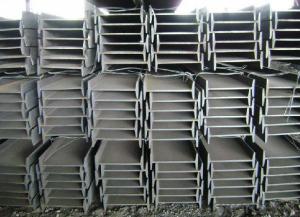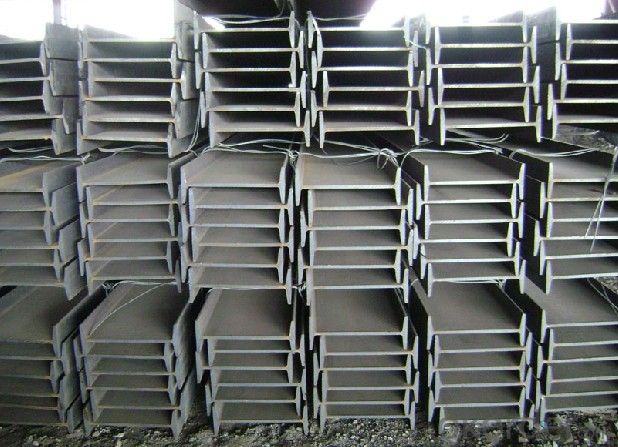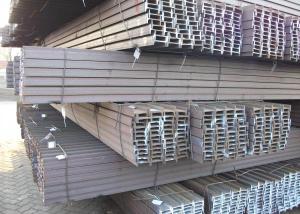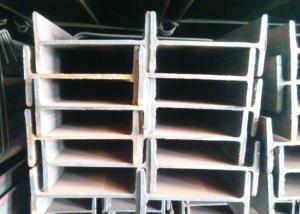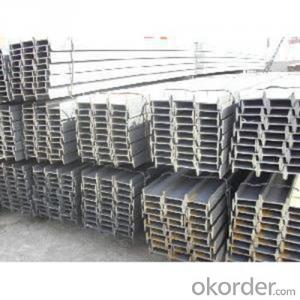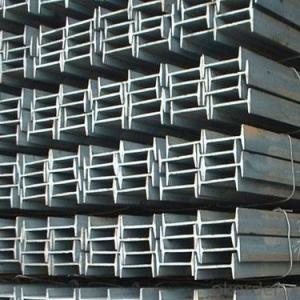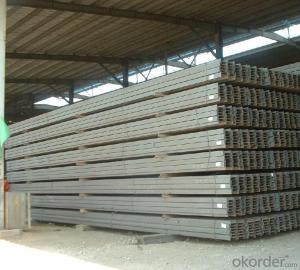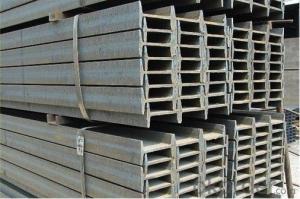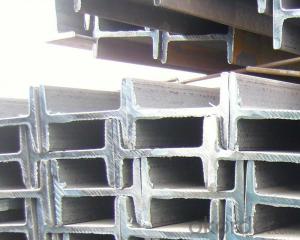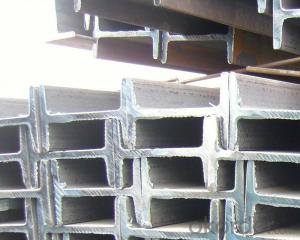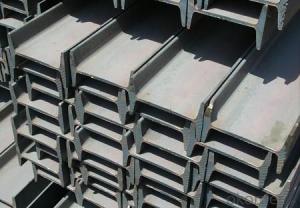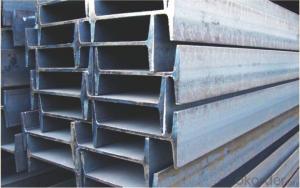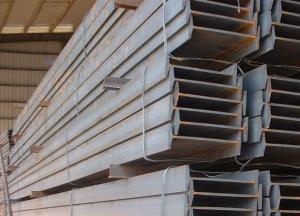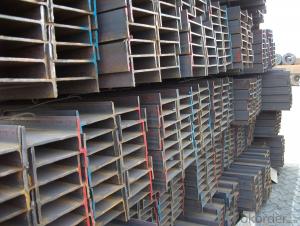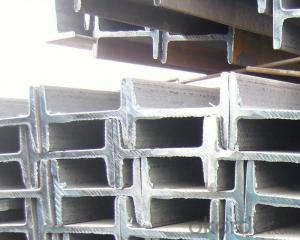IPEAA 80-270 HIGH QUALITY
- Loading Port:
- China Main Port
- Payment Terms:
- TT OR LC
- Min Order Qty:
- -
- Supply Capability:
- -
OKorder Service Pledge
OKorder Financial Service
You Might Also Like
Product Description:
IPEAA Beam Details:
| Minimum Order Quantity: | 10MT | Unit: | m.t. | Loading Port: | Tianjin Port, China |
| Supply Ability: | 10000MT | Payment Terms: | TT or LC | | |
Product Description:
Specifications of IPEAA Beam
1. Invoicing on theoretical weight or actual weight as customer request
2. Standard: EN10025, GB Standard, ASTM
3. Grade: Q235B, Q345B, SS400, ASTM A36, S235JR, S275JR
4. Length: 5.8M, 6M, 9M, 12M as following table
5. Sizes: 80mm-270mm
Dimensions(mm) | |||||
| h | b | s | t | Mass Kg/m |
IPEAA80 | 80 | 46 | 3.80 | 5.20 | 6.00 |
IPEAA100 | 100 | 55 | 4.10 | 5.70 | 8.10 |
IPEAA120 | 120 | 64 | 4.80 | 6.30 | 10.40 |
IPEAA140 | 140 | 73 | 4.70 | 6.90 | 12.90 |
IPEAA160 | 160 | 82 | 5.00 | 7.40 | 15.80 |
IPEAA180 | 180 | 91 | 5.30 | 8.00 | 18.80 |
IPEAA200 | 200 | 100 | 5.60 | 8.50 | 22.40 |
IPEAA220 | 220 | 110 | 5.90 | 9.20 | 26.20 |
IPEAA240 | 240 | 120 | 6.20 | 9.80 | 30.70 |
IPEAA270 | 270 | 135 | 6.60 | 10.20 | 36.10 |
Appications of IPEAA Beam
1. Supporting members, most commonly in the house raising industry to strengthen timber bears under houses. Transmission line towers, etc
2. Prefabricated structure
3. Medium scale bridges
4. It is widely used in various building structures and engineering structures such as roof beams, bridges, transmission towers, hoisting machinery and transport machinery, ships, industrial furnaces, reaction tower, container frame and warehouse etc.
Package & Delivery of IPEAA Beam
1. Packing: it is nude packed in bundles by steel wire rod
2. Bundle weight: not more than 3.5MT for bulk vessel; less than 3 MT for container load
3. Marks: Color marking: There will be color marking on both end of the bundle for the cargo delivered by bulk vessel. That makes it easily to distinguish at the destination port.
4. Tag mark: there will be tag mark tied up on the bundles. The information usually including supplier logo and name, product name, made in China, shipping marks and other information request by the customer.
If loading by container the marking is not needed, but we will prepare it as customer request.
5. Transportation: the goods are delivered by truck from mill to loading port, the maximum quantity can be loaded is around 40MTs by each truck. If the order quantity cannot reach the full truck loaded, the transportation cost per ton will be little higher than full load.
6. Delivery of IPE Beam: 30 days after getting L/C Original at sight or T/T in advance
Production flow of IPEAA Beam
Material prepare (billet) —heat up—rough rolling—precision rolling—cooling—packing—storage and transportation
- Q: What are the common methods of connecting steel I-beams to concrete structures?
- Various factors, including load requirements, structural design, and project specifications, determine the choice of method for connecting steel I-beams to concrete structures. Some commonly employed techniques include: 1. Embedding: Steel I-beams are embedded directly into the concrete structure by pouring concrete around their ends. This results in a robust and stable connection between the steel beams and the concrete structure. 2. Welding: Steel plates or brackets are welded onto the ends of the beams and then embedded or bolted into the concrete. Welding offers a durable and strong connection, often used in applications with high loads. 3. Bolting: Steel plates or brackets with pre-drilled holes are attached to the beam ends, and these plates are secured to the concrete using anchor bolts. Bolting allows for easy installation and disassembly, making it suitable for temporary structures or situations requiring frequent adjustments. 4. Epoxy adhesive: Epoxy adhesive is utilized to connect steel I-beams to concrete structures where drilling or welding is not preferred or feasible. Steel plates or brackets are bonded to the concrete using epoxy adhesive, creating a reliable and aesthetically pleasing connection. 5. Mechanical connectors: Mechanical connectors, such as steel clamps or brackets, are commonly employed to connect steel I-beams to concrete structures. These connectors offer a secure and adjustable connection, facilitating easy installation and beam alignment. Mechanical connectors are typically used in applications requiring flexibility and adjustability. It is essential to note that the specific method for connecting steel I-beams to concrete structures may vary based on project requirements, local building codes, and engineering recommendations. Consulting a structural engineer or professional in the field is crucial to ensure the appropriate technique is chosen for a specific project.
- Q: Channel and I-beam are commonly used in construction sites. It is better to have on-site construction drawings, thank you
- Channel and I-beam are usually used to build floors.
- Q: What are the different finishes available for steel I-beams?
- There are several different finishes available for steel I-beams, each offering distinct advantages and characteristics. Some of the most common finishes include: 1. Mill finish: This is the most basic and common finish for steel I-beams. It is the result of the steel being rolled at the mill without any additional treatment or coating. Mill finish provides a natural, raw appearance, but it lacks corrosion resistance. 2. Galvanized finish: Galvanized steel I-beams are coated with a layer of zinc to enhance their corrosion resistance. The process involves dipping the beams in a bath of molten zinc, creating a durable and long-lasting finish. Galvanized I-beams are commonly used in outdoor or high-moisture environments. 3. Painted finish: Steel I-beams can also be painted to provide additional protection against corrosion and to enhance their appearance. The paint acts as a barrier between the steel and the surrounding environment, preventing rust and deterioration. Painted finishes are available in different colors to match specific aesthetic requirements. 4. Powder coating: Similar to painting, powder coating involves applying a dry powder to the surface of the I-beams. The powder is then heated, causing it to melt and form a protective coating. Powder coating offers excellent durability, resistance to chipping and scratching, and a wide range of color options. 5. Epoxy finish: Epoxy coatings provide exceptional corrosion resistance and are often used in industrial applications where the I-beams may be subjected to harsh chemicals or environments. The epoxy coating creates a strong barrier that prevents moisture and chemicals from reaching the steel surface. 6. Stainless steel finish: Stainless steel I-beams are made from a corrosion-resistant alloy that contains a high percentage of chromium. This finish provides excellent resistance to rust, staining, and corrosion, making it ideal for applications where hygiene and durability are crucial, such as in the food, pharmaceutical, and marine industries. In summary, the different finishes available for steel I-beams include mill finish, galvanized finish, painted finish, powder coating, epoxy finish, and stainless steel finish. Each finish offers unique benefits, such as corrosion resistance, aesthetic appeal, and durability, allowing for a wide range of applications and uses.
- Q: What is the typical lifespan of steel I-beams?
- The typical lifespan of steel I-beams can vary depending on several factors such as the quality of the steel used, the environment in which they are installed, and the level of maintenance provided. However, under normal conditions, steel I-beams are designed to have a very long lifespan. In general, they can last for several decades, if not longer, without any significant deterioration or structural issues. With proper care and maintenance, including regular inspections and necessary repairs, steel I-beams can remain structurally sound and functional for a very long time. It is important to note that factors such as exposure to corrosive environments or excessive loads can potentially shorten the lifespan of steel I-beams, so it is crucial to consider these factors when assessing their longevity. Additionally, advancements in steel manufacturing and coating technologies have further improved the durability and longevity of steel I-beams, making them even more reliable and long-lasting.
- Q: How do steel I-beams perform in terms of energy efficiency?
- Steel I-beams are known for their strength and durability, but when it comes to energy efficiency, they may not be the most ideal choice. Steel is a good conductor of heat, which means that it can easily transfer heat from the inside to the outside of a building or vice versa. This can result in significant energy loss when it comes to heating or cooling a space. Additionally, steel production is energy-intensive, requiring large amounts of energy to extract and refine iron ore and coal to produce steel. This process contributes to greenhouse gas emissions and is not considered environmentally friendly. However, it is important to note that energy efficiency is not solely determined by the choice of I-beams, but rather the overall design and construction of a building. Proper insulation, efficient HVAC systems, and energy-efficient windows can help mitigate the impact of steel I-beams on energy efficiency. Furthermore, steel I-beams offer advantages in terms of structural integrity and design flexibility, allowing for larger open spaces and longer spans. These benefits can lead to more efficient use of materials and potentially reduced construction costs. In conclusion, while steel I-beams may not be the most energy-efficient choice, their overall impact on a building's energy efficiency can be mitigated through other design and construction measures. It is important to consider the entire building envelope and energy systems when evaluating the energy efficiency of a structure.
- Q: Span 6 meters, 5 meters deep into the terrace, with steel frames from 4CM thick wood, used as light warehouse, I do not know what kind of I-beam, how layout?
- No problem. Remember to fill the joint of the I-beam and the wall with concrete, and connect the I-beam and the board together to make sure the 100% is safe!
- Q: Can steel I-beams be used in museums or art galleries?
- Certainly! Museums or art galleries can indeed utilize steel I-beams. These I-beams are widely employed in construction owing to their robustness and longevity. They are capable of offering structural support and stability to buildings, rendering them appropriate for use in places where hefty artwork or installations may be showcased. Moreover, steel I-beams possess aesthetic appeal and can be seamlessly integrated into the overall design of the area, contributing an industrial or contemporary touch to the interior. Nevertheless, it is vital to take into account the particular requirements of the museum or art gallery, including load-bearing capacity, weight distribution, and potential impact on the artwork. Seeking guidance from structural engineers and architects is imperative to ensure that the implementation of steel I-beams aligns with the specific needs of the space and the displayed artwork.
- Q: Are there any limitations to using steel I-beams?
- Yes, there are certain limitations to using steel I-beams. Here are some of the key limitations: 1. Weight: Steel I-beams can be quite heavy, making them difficult to transport and install without proper equipment or machinery. This can limit their use in certain construction projects or locations with limited accessibility. 2. Cost: Steel I-beams can be more expensive compared to other materials such as wood or concrete. The cost of steel itself, as well as the fabrication and installation processes, can contribute to higher overall project costs. 3. Span limitations: Steel I-beams have span limitations, meaning they may not be suitable for long spans without additional support or intermediate columns. The size and shape of the beam also influence its load-bearing capacity, so careful engineering calculations are required to ensure proper support. 4. Corrosion: While steel is a strong material, it is susceptible to corrosion when exposed to moisture or certain chemicals. Without proper protective coatings or maintenance, the structural integrity of steel I-beams can be compromised over time. 5. Fire resistance: Steel is not inherently fire-resistant, and in the event of a fire, it can lose its strength and integrity quickly. Fireproofing measures such as fire-resistant coatings or the use of fire-rated insulation may be required to enhance the fire resistance of steel I-beams. 6. Thermal conductivity: Steel has a high thermal conductivity, which means it can transfer heat and cold more easily compared to other materials. This can result in increased energy loss or thermal bridging if not properly addressed with insulation or thermal breaks. 7. Design flexibility: While steel I-beams offer significant design flexibility, there may be limitations in terms of certain architectural styles or aesthetics. The industrial look of exposed steel might not be suitable for all construction projects or desired building appearances. Despite these limitations, steel I-beams continue to be widely used in various construction applications due to their high strength, durability, and versatility. However, it is important to consider these limitations and consult with structural engineers, architects, and construction professionals to ensure the appropriate use of steel I-beams in any specific project.
- Q: What are the considerations for fire rating steel I-beams?
- When considering fire rating for steel I-beams, several factors need to be taken into account. First and foremost, the material used in the construction of the I-beams must be fire-resistant or have a high fire-resistant coating. Additionally, the size and shape of the beams, as well as their positioning and spacing, should be carefully evaluated to ensure proper fire protection. It is also crucial to consider the fire rating requirements specified by local building codes and regulations. Regular inspections and maintenance of the I-beams are necessary to ensure their fire resistance remains intact over time.
- Q: How do steel I-beams perform in terms of impact resistance?
- The exceptional impact resistance of steel I-beams is well-known. The I-beam's unique design, with its flanges and web, provides a high level of strength and rigidity, making it highly effective at withstanding impact forces. When an impact occurs, the I-beam evenly distributes the force along its length, preventing deformation or failure. The impact resistance of steel is further enhanced by its structural properties, such as its high tensile strength and toughness. Steel is one of the strongest construction materials available, allowing I-beams to withstand heavy loads and absorb the energy of impacts without significant damage. In applications where impact resistance is crucial, steel I-beams are frequently used, such as in building structures, bridges, and industrial facilities. These beams can effectively withstand dynamic loads, including sudden impacts, collisions, and even natural disasters like earthquakes or strong winds. It is important to note that the specific impact resistance of steel I-beams can vary based on factors such as beam size and shape, the grade and quality of the steel used, and the design and construction techniques utilized. Therefore, it is essential to select the appropriate type of I-beam and ensure proper engineering and installation practices to maximize impact resistance.
Send your message to us
IPEAA 80-270 HIGH QUALITY
- Loading Port:
- China Main Port
- Payment Terms:
- TT OR LC
- Min Order Qty:
- -
- Supply Capability:
- -
OKorder Service Pledge
OKorder Financial Service
Similar products
Hot products
Hot Searches
Related keywords
